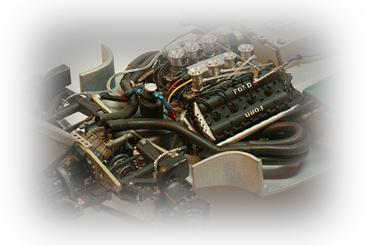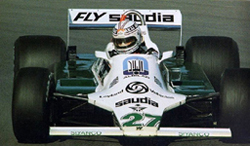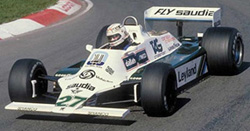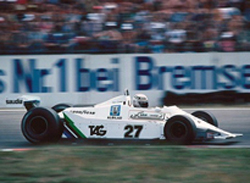The Williams FW07 was designed by Patrick Head for the 1979 F1 season and was classed as a ground effect car similar to the Lotus 79. It is said that the car was even developed in the same wind tunnel belonging to the Imperial College, London. Upon it's release the car caused a stir due to the similarities to the Lotus car, among them Lotus aerodynamicist Peter Wright who felt the FW07 was little more than a re-engineered Lotus 79 with a different coloured bodyshell. Powered by the ubiquitous Ford Cosworth DFV engine, the car was small and simple and extremely light with extremely clean lines and beautiful styling, most agreed that it seemed to be a strong challenger for the new season, sadly early reliability problems halted any serious threat for the title.
Whilst Colin Chapman's Lotus 78 was the first ground effect car - the predecessor to the Lotus 79, many thought that Patrick Head may have had a better grasp of the principles than Chapman.
The car's debut was partway through the 1979 season, and in the hands of Alan Jones and Clay Regazzoni served to make the Williams team a genuine contender for perhaps the first time. It was Jones, who took Williams' first win in that year, at the British Grand Prix, going on to record four wins from the next five races with the car. At the end of the 1979 championship season the honours went to Ferrari, however Williams had established themselves as the team to beat for 1980.
In the following 1980 season the FW07 became the FW07B. Regazzoni was replaced by the enigmatic Carlos Reutemann, and while he and Jones formed a successful partnership, there was clearly a tension between the two drivers. Both developed the car further, improving areas such as setup and suspension. Later on into it's development such was the success of it's ground effects, the engineers decided that the car now no longer needed the front wings and these were subsequently removed. The hours of testing and development paid dividends for the Williams team, Jones won five races in Argentina, France, Britain, Canada and the USA and went on to win his only world championship, while Reutemann won at a wet Monaco. The nearest challenge came from Brabham's BT49 in the hands of Nelson Piquet. It also saw Williams go on to win their first of many constructors' championships.
This is going to be a full detail build, I have very little grade up parts for this car so the vast majority of details will have to scratch made. I am also going to use an old built FW07 car to build the FW07B car alongside this, this second car will be curbside only and have a fixed cover with no engine refinements.
A big thanks need to go to Derek Collins at http://www.iconautomotiveminiatures.com for his help with the wheels, tyres and excellent decals for both builds, thanks again Derek.
 |
| Click above for build and completed pictures |
|
|
 |
| Alan Jones - 1980 French GP (FW07B) |
 |
| Alan Jones - 1980 British GP (FW07B) |
 |
| Alan Jones - 1979 German GP (FW07) |
|



